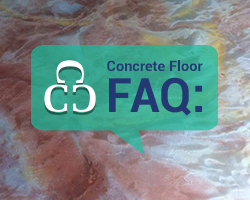
Each week we dive into specific topics concerning concrete such as tips for staining concrete, best methods for stripping sealers, and how to waterproof a foundation. This week though, we’d like to take a step back to answer some frequently asked questions regarding concrete for both residential and commercial needs. Questions range from very technical to those more aesthetically-based. Toward whichever end you skew, we hope you find answers to those long-burning questions concerning concrete.
What is the difference between cement and concrete?
While some often confuse concrete and cement, as the two terms are often used interchangeably, it is important to note the difference. Cement is merely one of the ingredients used to form concrete while concrete itself is the end product. Well, what other ingredients are used in the production of concrete and how exactly is it made? We’re glad you asked...
What is concrete and how is it made?
Now that you know the difference between cement and concrete, you may be wondering how exactly concrete is made. So what is concrete? In short, concrete is a mixture of paste and aggregates. The paste, made of portland cement and water, and the aggregates, rocks ranging from fine (smaller) and coarse (larger), are mixed together wherein the paste coats the aggregates. A chemical reaction then occurs in which the paste hardens and becomes the rock-like mass known as concrete. This chemical reaction is called hydration and is the cornerstone of concrete production.
To learn how cement is made click here; and for a more comprehensive look at how concrete is made, click here.
What are the benefits of using concrete?
How could you even ask us a question like this when there are so many? To name a few, though, concrete is more versatile, sustainable, and durable than other building materials yielding lower maintenance and lower costs, making it one of the most preferred materials in the world.
Durability
Because of the nature of the product, the use of concrete always produces a strong and solid end result that will persist throughout time and conditions. This is true for both its use in flooring as well as in structures. When used in structures, concrete protects against both typical and extreme weather, like natural disasters, providing a safe and comfortable shelter for its inhabitants. This also helps to minimize property damage saving owners money.
Versatility
Concrete is able to be used in a number of different ways making it one of the most versatile building materials in the world. Due to this characteristic, concrete is used as the main structural component in many low and high-rise buildings all over the world. In addition to its use in structures, concrete’s more known form is its use as a flooring material. Its versatility allows it to be manipulated to give you almost any aesthetic look you’d like to achieve. Below, we’ll provide you with some of the decorative flooring options you have regarding concrete.
Sustainability
Additionally, concrete is proven to be one of the more sustainable building materials when compared to other alternatives. The use of concrete as a building material minimizes air filtration and simplifies the addition of insulation. Concrete’s thermal mass also provides consistent temperatures and decreased energy usage. All of these factors combined makes concrete a sustainable alternative as its use yields a lower environmental impact.
All of these elements combined makes concrete an inexpensive alternative in both the long and short run when compared to other building materials.
What sort of options do I have when it comes to an aesthetic look?
As previously mentioned, concrete is a versatile building material. Meaning, not only can it be utilized for a number of different structures, it can also be transformed to give your home or commercial space nearly any aesthetic look you choose. Options for decorative concrete floors include polished, stained, metallic, adding various color pigments, and rustic concrete wood. Geometric patterns can also be scored, stamped, or inlaid into the concrete to mirror the look of stone, brick or tile paving. The versatility of the product allows it to be whatever you need it to be to fulfill the specific aesthetic look you’re trying to achieve.
These are only a few of the many questions you may have concerning concrete although we hope this has been an informative overview! To learn more about concrete, check out some additional FAQs by clicking here.
There are so many creative and custom options for finishing concrete, but first and foremost important is the concrete itself. At Custom Concrete Creations we have state of the art equipment and a properly trained team with years of experience. Custom Concrete Creations is a premier contractor serving the Omaha area as well at the Midwest. Give us a call or send us an email for your custom concrete finishing needs today!
